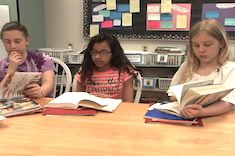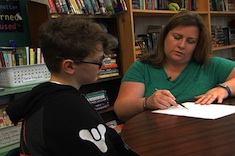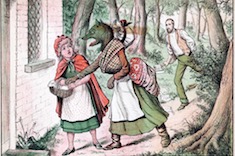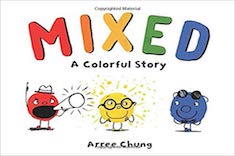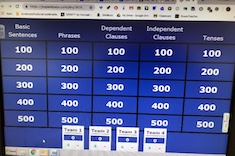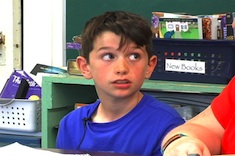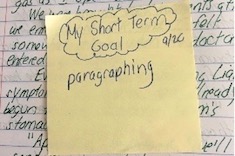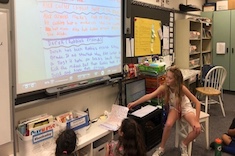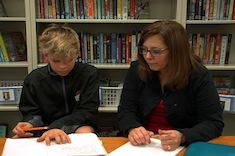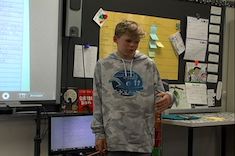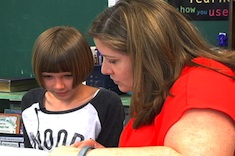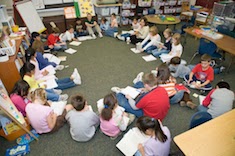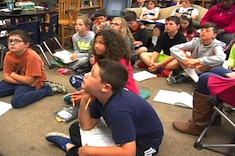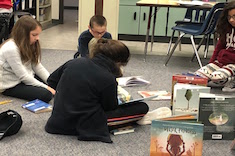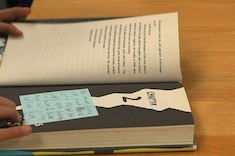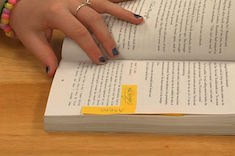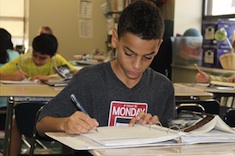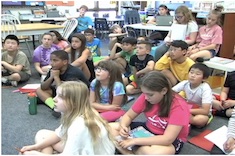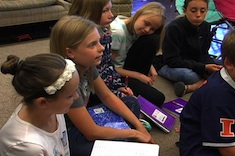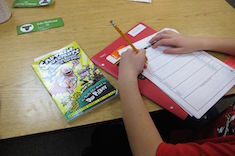5th
Latest Content
Getting Started with Strategy Lessons
Tara Barnett and Kate Mills describe how they help teachers move from guided reading to strategy groups in the upper elementary grades.
Digital and Disney: Conferring with Ben
It would be easy to zip quickly through a writing conference about a vacation story, especially one about a trip to Disney. In this video, Franki Sibberson slows down with Ben to explore how he is meeting his goal of adding descriptive language to writing, using digital tools to assist.
A Minilesson on Minilessons
Franki Sibberson leads a minilesson in her fifth-grade classroom to help students design their own lessons. Students also assess what goes into a high-quality minilesson.
Small Group: Creativity
Franki Sibberson pulls together a group of fifth graders to explore writing mentors together.
Student-Led Minilesson: Annotating Reading with Sticky Notes
Students can claim who they are as readers and writers by designing and presenting minilessons to their peers. In this week’s video, fifth grader Reagan from Franki Sibberson’s classroom presents a lesson on annotating reading with sticky notes.
Scaffolding Revision with a Mentor Text
Tara Barnett and Kate Mills show how to break down mentor texts into brief excerpts for step-by-step scaffolding of writers in the intermediate grades.
Exploring Dystopian Literature: Fifth-Grade Reading Conference
Katherine Sokolowski confers with Ian about The Giver, broadening his understanding of the text to consider other dystopian literature.
Bringing Multiple Texts and Perspectives into Teaching Point of View
Katherine Sokolowski finds her students are struggling to understand point of view. She takes a detour over a week with mentor texts, quick assists from favorite writers on Twitter, and practice sessions retelling Little Red Riding Hood to teach the concept.
Detour Texts
Clare Landrigan and Tammy Mulligan explain the concept of “detour texts”—picture books to use as mentor texts in the intermediate grades to illustrate complex literary elements. They also share three of their favorite new children’s books to use as detours.
Thoughtful Read Aloud Structures
Franki Sibberson shares how she integrates student choice and collaboration into reading response during daily read alouds.
Grammar Games
Melanie Meehan shares two of her favorite games for teaching grammar, including templates and web resources.
Practical Advice for Dealing with Messy Handwriting
Do struggles with handwriting matter? They do when a student can’t even decipher his own words. Katherine Sokolowski confers with fifth grader Sauvi to help him find solutions to the problem.
Building Habits with Short-Term Goals
Tara Barnett and Kate Mills explain why short-term writing goals can help students reset expectations for their writing on a daily basis, and how they make these goals an integral part of their writing workshops.
Student-Led Minilessons in Fifth Grade
Franki Sibberson initiates student-led minilessons, and finds the process takes her literacy workshops to a new level of independence and energy.
Planning a Student-Led Minilesson
Franki Sibberson helps Lucas plan his minilesson for his fifth-grade classmates on how to connect words and facts from two different sources.
Student-Led Minilesson: Connecting Facts from Different Sources
Lucas leads a minilesson in Franki Sibberson’s fifth-grade class on connecting facts from different sources.
A Poem About Lost Friendship: Conferring with Estelle
Estelle shares a poem she has written about lost friendship with her teacher, Katherine Sokolowski. She captures the fickle nature of fifth-grade relationships among girls. Katherine connects the cadence of the writing to the style of The Crossover, and helps Estelle find possibilities for more writing.
Annotating While Reading
Franki Sibberson finds teaching students to annotate while reading is one of the best ways to promote ongoing reflective response in her fifth-grade classroom. She shares how she starts teaching annotation skills early in the year.
Fifth-Grade Book Talk: Wish Girl
Katherine Sokolowski builds interest in a new book in the classroom library through a book talk on Wish Girl.
Keeping the Classroom Library Current
Franki Sibberson explains how she watches students closely and adjusts her library based on what she sees all year long.
Invitations vs. Accountability
It’s not an invitation if students are required to accept it. Franki Sibberson explains how engagement depends upon true choice and lots of options in her fifth-grade classroom.
Student Notes: Slow Down and Think
Fifth grader Orion uses sticky notes to make questions and predictions at the end of each chapter.
Student Notes: Reading for Writing
Reagan, a fifth grader in Franki Sibberson's class, explains how she uses sticky notes to flag examples of writer's craft she could use in her own writing.
Student Notes: Reminders for Later
We continue our video series from Franki Sibberson's class of fifth graders explaining how they take notes while reading. Sarah marks important elements early in the mystery she is reading, so she can easily refer to them later.
Writing Routines: Drafting Autonomy
Justin Stygles questions his conferring routine during writing workshops, and the value of interrupting students early in the drafting process.
Student Notes: Keeping Track of Many Characters
Tre uses lots of sticky notes to sort through and keep track of characters in a book with a whole classroom full of personalities.
Leads Minilesson
This fifth-grade minilesson from Franki Sibberson is a lovely mix of mentor texts, Franki's own writing, and honesty about the writing process.
Independent Project Hiccups
Tara Barnett and Kate Mills conclude their series on independent projects with advice on how to handle issues that often crop up as students design and work through writing their projects.
Group Meeting: Sharing Resources for Animal Study
Katherine Sokolowski helps her fifth-grade students expand their territory for their animal research projects by sharing information sources and peer connections.
Reimagining Reading Logs
Reading logs have fallen out of favor in many classrooms because they often become a rote activity for recording pages read. Tara Barnett and Kate Mills find authenticity with the logs comes when they move from emphasizing recording to goals and reflection.
Browse Content By
Type
Category
- Assessment Tools
- Big Fresh Archives
- Booklists
- Choice Numeracy
- Classroom Design
- Common Core
- Community Building
- Conferring
- Content Literacy
- Digital Literacy
- English Language Learners
- Equity
- Family Relations
- Free Samples
- Guiding Groups
- Leadership
- Literacy Coaches
- Mentor Texts
- Minilessons
- New Teacher Mentors
- Podcasts
- Poetry
- Quote Collections
- Reading Strategies
- Self Care
- Struggling and Striving Learners
- Talking and Listening
- Teacher Study Groups
- Teaching Reading
- Teaching Writing
- Word Study and Vocabulary
Author
- Melissa Quimby
- Nawal Qarooni
- Gwen Blumberg
- Julie Cox
- The Lead Learners
- Hannah Tills
- Josie Stewart
- Ruth Metcalfe
- Mallory Messenger
- Becca Burk
- Jodie Bailey
- Vivian Chen
- Mary Brower
- Tiffany Abbott Fuller
- Stephanie Affinito
- Ruth Ayres
- Leigh Anne Eck
- Heather Fisher
- Shari Frost
- Julie Johnson
- Suzy Kaback
- Gigi McAllister
- Shirl McPhillips
- Melanie Meehan
- Cathy Mere
- Debbie Miller
- Tara Barnett and Kate Mills
- Tammy Mulligan
- Dana Murphy
- Bitsy Parks
- David Pittman
- Brenda Power
- Heather Rader
- Matt Renwick
- Mandy Robek
- Christy Rush-Levine
- Gretchen Schroeder
- Jen Schwanke
- Brian Sepe
- Katherine Sokolowski
- Stella Villalba
- Jennifer Vincent
Grade Level
Choice Literacy Membership
Articles
Get full access to all Choice Literacy article content
Videos
Get full access to all Choice Literacy video content
Courses
Access Choice Literacy course curriculum and training



